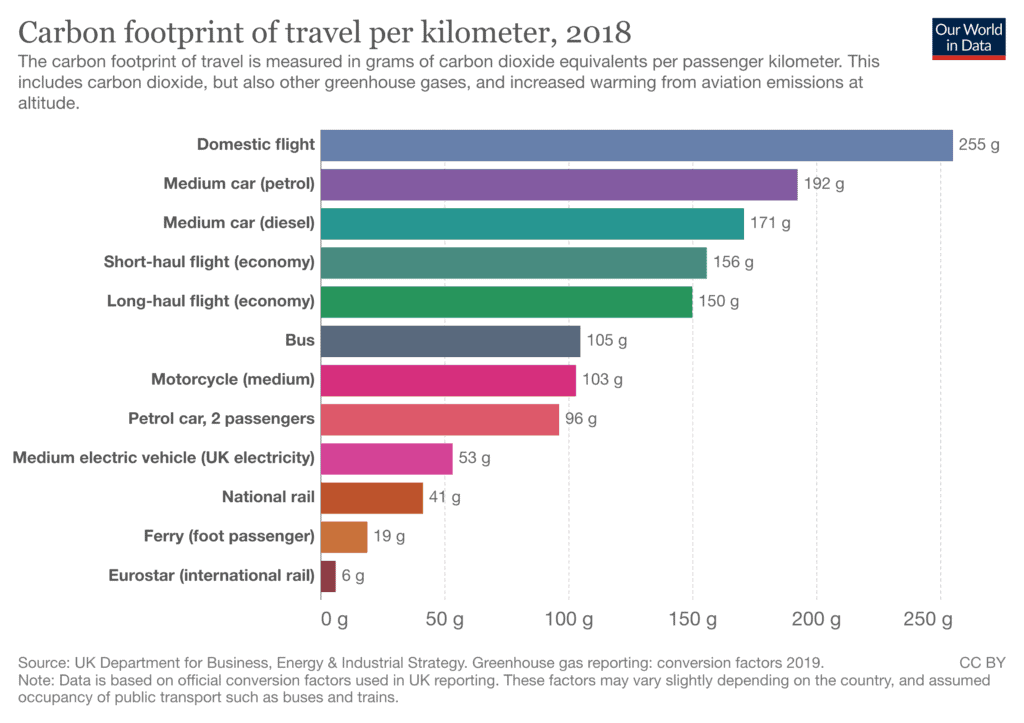
This is our resource page for sustainable transportation choices looking at how we can get our miles from less carbon.
What is low carbon or sustainable transportation
Low carbon or sustainable transportation are modes by which people and goods travel with a reduced reliance on fossil fuels. Low carbon transportation includes walking, bicycling, public transit, carpooling, and electric vehicles. Sustainable transportation is one that meets the needs of the present without compromising the future.
Quantifying carbon emission lets us compare sustainable transportation options
Let’s take a look at what makes walking and bicycling the top modes in consideration of carbon emission. First off, the amount of carbon emitted on a plane flight is much higher than a typical car ride. This is due to the distance traveled.
Therefore to compare any two modes of transportation one should consider on a per mile or per kilometer basis. Second, obviously we need to talk about carbon emission per individual. This is because vehicles like buses are more efficient by carrying a group rather than individuals. The bus is also pulling its own weight.
So one needs to consider the emission numbers on a per person level. With that in mind, the chart on top shows the emission of grams of carbon per kilometer traveled. The units are on a per person basis.
Winners and Losers
And surprisingly, despite a plane carrying many people, domestic flights are just about the worst for carbon emissions. The study also includes a category of short and long haul flights that are not as bad.
The second worst are the personal cars. In countries like the U.S., these are certainly contributing massively to carbon production. Then as one would expect, public transportation, small vehicles like motorcycles, are much much better.
Comparing to walking and cycling
What’s not in the chart are numbers for what we mentioned at the beginning of the article: walking and cycling. We claim these are the best, but really what are the numbers of walking and cycling? When a person walks or bikes, he or she is a carbon emitter too. Are these vastly different compared to motorized transportation? It turns out yes.
A controversial study
A study in the scientific journal Nature concluded the following:
Based on the average global diet18, emissions required for walking are up to 0.11 kgCO2e/km (95% uncertainty interval (UI) 0.05 to 0.22)) and up to 0.14 kgCO2e/km (95% UI 0.06 to 0.28)) for cycling when energy expenditure is fully compensated with increased energy intake (Fig. 1)
Mizdrak, A., Cobiac, L.J., Cleghorn, C.L. et al. Sci Rep 10, 9196 (2020)
That puts walking and cycling at 110 g CO2 e/km and 140 g CO2 e/km respectively, which makes these on par with buses and short haul flights!
Making your personal choice
It seems like there’s controversy and uncertainty as to whether walking and cycling are truly much less efficient than cycling. So what’s the bottom line? We suggest that as long as you’re using a mode on the bottom half of the list, you’re doing the right thing.
Other sustainable transportation modes omitted here are e-bikes and e-scooters which have grown in popularity in recent years and being battery driven and therefore untethered to fossil-fuel are also contenders for sustainable modes of transport.
Ideas for sustainable transportation options

Electric bikes and scooters
First idea for a low carbon intensity way to travel is using electric bikes and electric scooters which are much more efficient than cars and other gas-powered vehicles. They are also much quieter, which helps reduce noise pollution. They make most sense for short commutes and distances because the batteries won’t last more than a few hours. Besides commutes, it’s also an option to think about for leisure, whether that’s at home or using an ebike on a vacation as we’ve promoted.
Go hybrid rather than electric
Second idea is instead of going full electric to go for a hybrid car. The advantage of a hybrid car over a full electric car is that a hybrid car can run on both gasoline and electricity, while a full electric car can only run on electricity.
This means that a hybrid car can go further on a tank of gas than a full electric car can on a single charge. In addition, hybrid cars are generally less expensive than full electric cars.
Car pool for a low tech way to make an impact
Good transportation options will reduce the carbon footprint and pollution. One example is car-pooling to work. This will reduce the number of cars on the road and the amount of pollution that is being put into the air.
To get started, first talk to your co-workers and see if anyone is interested in car-pooling; second, find out the best route to take to avoid traffic; third, take turns driving each week; fourth, make sure everyone is comfortable with the route and the plan before getting started.
Original study:
Mizdrak, A., Cobiac, L.J., Cleghorn, C.L. et al. Fuelling walking and cycling: human powered locomotion is associated with non-negligible greenhouse gas emissions. Sci Rep 10, 9196 (2020). https://doi.org/10.1038/s41598-020-66170-y
